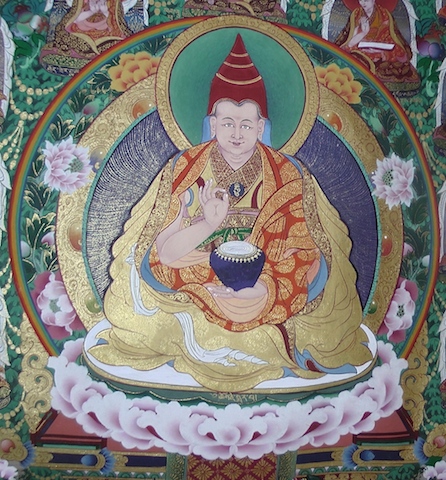


Choje Marpa Sherab Yeshe (1134-1203), the founder of the Martsang Kagyu tradition of Tibetan Buddhism, was born in Markham, in East Tibet and now resides in Akshobhya Buddha pure land.
As a child, Choje Marpa took a great interest in Buddhism and at the age of fifteen, he trekked off into the snow-covered mountains in search of the renowned local teacher, Lama Gomgyawa. Choje Marpa camped with Lama Gomgyawa for several years, preparing the food and collecting wood for the fire, while taking every opportunity to receive his teachings.
At the age twenty-one, Choje Marpa traveled to the famous Sangpu Institute, the great monastic college of the Kadampa tradition, where he studied Buddhist theory, logic and philosophy in great detail. However, after 5 years, he developed a strong urge to study meditation and so headed to the monastery of Phagmo Drupa, a disciple of Gampopa, the founder of the Kagyu School. Initially Phagmo Drupa refused to teach him and sent him away without instruction. Choje Marpa kept returning, pleading for teachings, until eventually Phagmo Drupa simply pointed to a rock and told him: “Do not think of the past. Do not think of the future. Do not even think of the present. Simply sit there”.
Choje Marpa followed his master’s instructions, but after some days, one of the other monks walked by and asked what he was doing sitting on a rock. “Meditating?” his colleague laughed, and then pointing at an old lady resting nearby, “Well, if that’s meditation, then that old lady’s meditating too!” Embarrassed and filled with worry, Choje Marpa ran to see his master. Phagmo Drupa looked disapprovingly and replied, “Your biggest enemy is doubt. If you do not believe in me, then you are free to leave. If my instructions do not work, then they are not the teachings inherited from the great Nagarjuna”. These words filled Choje Marpa with joy and he returned to sit in meditation with a renewed vigor.
After a year of sitting in isolation, Choje Marpa returned to see his master. While he had followed his master’s instructions, he had faced many obstacles and still had many questions. Choje Marpa sat next to Phagmo Drupa and told him all of his concerns. At the end, Phagmo Drupa opened his eyes and looked at him with a radiant smile. At that instant, Choje Marpa experienced a surge of bliss, his mind became completely clear and all of his doubts disappeared.
Choje Marpa stayed with Phagmo Drupa, receiving and mastering many profound and secret teachings. However, after five years, Phagmo Drupa told him that it was time for him to return to Markham to teach. On that day, Phagmo Drupo took him into the main hall of the monastery and placed his hat on Choje Marpa’s head, to signify that he had inherited his teachings and was now a disciple of the Kagyu School.
When he first returned to Markham, Choje Marpa went into retreat in a mountain cave to further practice. As the years passed, word spread of an accomplished master in the mountains and people came to receive blessings and listen to his teachings. As his followers grew, the first monastery, the Shuksep Monastery, was established. From this point onwards, the lineage and school of Choje Marpa was known as Martsang Kagyu, based on its home in Markham and as a union of the Kadampa and Kagyu lineages. The school emphasized the importance of combining a strong foundational understanding of the sutra, with a practical understanding of the tantra. During his lifetime, the monastic community came to number more than two thousand.
Despite his dedicated following, Choje Marpa knew that the Martsang Kagyu lineage would face great difficulties and although, the teachings were traditionally passed down through oral instructions, Choje Marpa asked his disciples to carefully record the teachings in writing. We are very fortunate that Gangri Karma Rinpoche has diligently researched, preserved and translated these teachings.
“The mind’s fundamental nature is clear and empty like the sky.
Meditation is effortless and the precious qualities of realization arise on their own accord.
Mental activities that are grasped as self-existent, fade away spontaneously.
The body and mind become tranquil and peaceful.
A union of calm abiding and special insight naturally arises.
The fortunate ones spontaneously attain great bliss.
The body of Dharmata as well as the state of Buddhahood.”
In 1203, Choje Marpa passed away and it is said that on that day, snowflakes fell to the ground like white flower petals and that rainbows of radiant colour filled the sky. Choje Marpa’s body was cremated in a ceremony attended by over one thousand students, including his closest two disciples: Drogon Rinchen and Yishi Gyaltsen. When they opened the incinerator, they found that his skeleton, tongue and heart were immaculately preserved in the ash, representing the body, speech and mind of a great master. His followers bowed in great awe and many people came from far and wide to climb the mountain and pay homage.
Please respect Intellectual Property Rights. Any copy without written consent form the site is subject to legal actions.